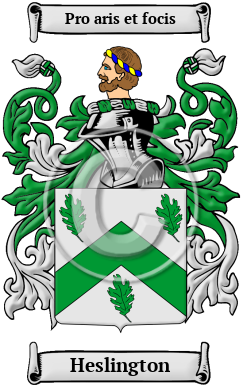| ![Show Contents]() Heslington History, Family Crest & Coats of Arms Heslington History, Family Crest & Coats of Arms
Etymology of HeslingtonWhat does the name Heslington mean? The Anglo-Saxon name Heslington comes from when the family resided in one of a variety of similarly-named places. The parishes of Cold Hesleton (Hesleden) and Monk Hesleton (Hesleden) are in Durham. Both date back to Saxon times when they were collectively known as Heseldene c. 1050 and literally meant "valley where hazels grow." 1 Haslingden in Lancashire dates back to 1241 when it was known as Heselingedon and meant "valley where hazels grow." 1 Hazeldon Farm is in Wiltshire, and Hazelton is in Gloucestershire. The surname Heslington belongs to the large category of Anglo-Saxon habitation names, which are derived from pre-existing names for towns, villages, parishes, or farmsteads. Early Origins of the Heslington familyThe surname Heslington was first found in Sussex at ancient manor in or near Dallington. 2 The name is derived from the Old English words hoesel + denu, which mean "Hazel" + "valley." 3 Hazleton Abbey was an abbey in Gloucestershire. Early rolls revealed Robert de Heseldene in the Assize Rolls for Surham in 1243; Alexander de Haselinden in Kirkstal, Yorkshire in 1258; Reginald de Haselden in the Hundredorum Rolls for Warwickshire in 1275; and William de Heseldenn in the Subsidy Rolls for Sussexin in 1296. 4 In Somerset, early records there found: William de Haseldin; and Adam Haseldene, both listed 1, Edward III (during the first year of King Edward III's reign.) 5 The Yorkshire Poll Tax Rolls of 1379 included: Willelmus de Hesledyn; and Jeppe de Hesilden as both hold lands there at that time. 6 Early History of the Heslington familyThis web page shows only a small excerpt of our Heslington research. Another 66 words (5 lines of text) covering the years 1595, 1690, 1710, 1740 and 1763 are included under the topic Early Heslington History in all our PDF Extended History products and printed products wherever possible. Heslington Spelling VariationsThe English language only became standardized in the last few centuries; therefore,spelling variations are common among early Anglo-Saxon names. As the form of the English language changed, even the spelling of literate people's names evolved. Heslington has been recorded under many different variations, including Hazeltine, Hazelton, Hazletine, Hasleden, Hazleton, Haseltine, Haselton, Hasletine, Haslett, Aseltine and many more. Early Notables of the Heslington familyNotables of the family at this time include Thomas Haselden (d. 1740), English mathematician who was for some time schoolmaster at Wapping Old Stairs, and afterwards 'head-master of the Royal Academy at Portsmouth.' 7Richard Hasleton (fl. 1595), was an English traveller who has related his travels in the very scarce 'Strange and wonderful things happened to Rd. Hasleton, borne at Braintree...
Another 61 words (4 lines of text) are included under the topic Early Heslington Notables in all our PDF Extended History products and printed products wherever possible. Migration of the Heslington family to IrelandSome of the Heslington family moved to Ireland, but this topic is not covered in this excerpt.
Another 41 words (3 lines of text) about their life in Ireland is included in all our PDF Extended History products and printed products wherever possible.
| Heslington migration to New Zealand | + |
Emigration to New Zealand followed in the footsteps of the European explorers, such as Captain Cook (1769-70): first came sealers, whalers, missionaries, and traders. By 1838, the British New Zealand Company had begun buying land from the Maori tribes, and selling it to settlers, and, after the Treaty of Waitangi in 1840, many British families set out on the arduous six month journey from Britain to Aotearoa to start a new life. Early immigrants include: Heslington Settlers in New Zealand in the 19th Century- Mr. Benson Heslington, (b. 1857), aged 21, British settler travelling from London aboard the ship "Western Monarch" arriving in New Zealand in 1879 8
The motto was originally a war cry or slogan. Mottoes first began to be shown with arms in the 14th and 15th centuries, but were not in general use until the 17th century. Thus the oldest coats of arms generally do not include a motto. Mottoes seldom form part of the grant of arms: Under most heraldic authorities, a motto is an optional component of the coat of arms, and can be added to or changed at will; many families have chosen not to display a motto.
Motto: Pro aris et focis
Motto Translation: For our altars and our homes
- Mills, A.D., Dictionary of English Place-Names. Oxford: Oxford University Press, 1991. Print. (ISBN 0-19-869156-4)
- Lower, Mark Anthony, Patronymica Britannica, A Dictionary of Family Names of the United Kingdom. London: John Russel Smith, 1860. Print.
- Hanks, Patricia and Flavia Hodges, A Dictionary of Surnames. Oxford: Oxford University Press, 1988. Print. (ISBN 0-19-211592-8)
- Reaney, P.H and R.M. Wilson, A Dictionary of English Surnames. London: Routledge, 1991. Print. (ISBN 0-415-05737-X)
- Dickinson, F.H., Kirby's Quest for Somerset of 16th of Edward the 3rd London: Harrison and Sons, Printers in Ordinary to Her Majesty, St, Martin's Lane, 1889. Print.
- Bardsley, C.W, A Dictionary of English and Welsh Surnames: With Special American Instances. Wiltshire: Heraldry Today, 1901. Print. (ISBN 0-900455-44-6)
- Smith, George (ed), Dictionary of National Biography. London: Smith, Elder & Co., 1885-1900. Print
- New Zealand Yesteryears Passenger Lists 1800 to 1900 (Retrieved 26th March 2019). Retrieved from http://www.yesteryears.co.nz/shipping/passlist.html
 |

